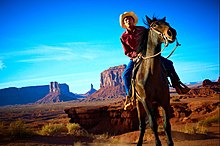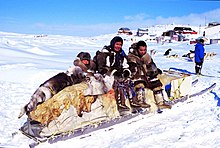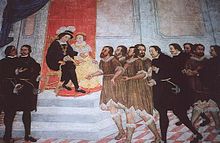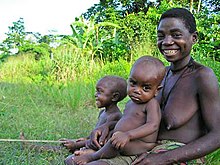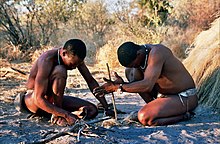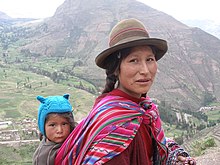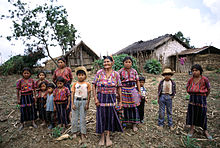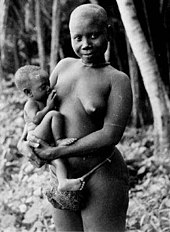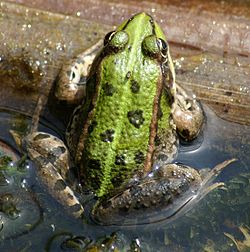A Navajo man on horseback in Monument Valley, Arizona, United States
Inuit on a traditional qamutik (dog sled) in Cape Dorset, Nunavut, Canada
Indigenous peoples, also known as first peoples, aboriginal peoples or native peoples, are ethnic groups
who are the original settlers of a given region, in contrast to groups
that have settled, occupied or colonized the area more recently. Groups
are usually described as indigenous when they maintain traditions or
other aspects of an early culture that is associated with a given
region. Not all indigenous peoples share this characteristic, as many
have adopted substantial elements of a colonizing culture, such as
dress, religion or language. Indigenous peoples may be settled in a
given region (sedentary) or exhibit a nomadic
lifestyle across a large territory, but they are generally historically
associated with a specific territory on which they depend. Indigenous
societies are found in every inhabited climate zone and continent of the world.
Since indigenous peoples are often faced with threats to their sovereignty,
economic well-being and their access to the resources on which their
cultures depend, political rights have been set forth in international
law by international organizations such as the United Nations, the International Labour Organization and the World Bank. The United Nations has issued a Declaration on the Rights of Indigenous Peoples
(UNDRIP) to guide member-state national policies to the collective
rights of indigenous peoples, such as culture, identity, language and
access to employment, health, education and natural resources. Estimates
put the total population of indigenous peoples from 220 million to 350
million.
International Day of the World's Indigenous Peoples is celebrated on 9 August each year.
Definitions
The adjective indigenous was historically used to describe animals and plant origins. During the late twentieth century, the term Indigenous people
began to be used to describe a legal category in indigenous law created
in international and national legislations; it refers to culturally
distinct groups affected by colonization. It is derived from the Latin word indigena, which is based on the root gen- 'to be born' with an archaic form of the prefix in 'in'. Notably, the origins of the term indigenous is not related in any way to the origins of the term Indian which until recently was commonly applied to indigenous peoples of the Americas. Any given people, ethnic group or community may be described as indigenous in reference to some particular region or location that they see as their traditional indigenous land claim. Other terms used to refer to indigenous populations are aboriginal, indigenous, original, or first (as in Canada's First Peoples (First Nations, Inuit and Métis)).
The use of the term peoples in association with the indigenous is derived from the 19th century anthropological and ethnographic disciplines that Merriam-Webster Dictionary defines as "a body of persons that are united by a common culture, tradition, or sense of kinship, which typically have common language, institutions, and beliefs, and often constitute a politically organized group".
James Anaya, former Special Rapporteur on the Rights of
Indigenous Peoples, has defined indigenous peoples as "living
descendants of pre-invasion inhabitants of lands now dominated by
others. They are culturally distinct groups that find themselves
engulfed by other settler societies born of forces of empire and
conquest".
They form at present non-dominant sectors of society and are
determined to preserve, develop and transmit to future generations their
ancestral territories, and their ethnic identity, as the basis of their
continued existence as peoples, in accordance with their own cultural
patterns, social institutions and legal system. The International Day of the World's Indigenous People
falls on 9 August as this was the date of the first meeting in 1982 of
the United Nations Working Group of Indigenous Populations of the
Subcommission on Prevention of Discrimination and Protection of
Minorities of the Commission on Human Rights.
National definitions
Throughout history, different states designate the groups within
their boundaries that are recognized as indigenous peoples according to
international or national legislation by different terms. Indigenous
people also include people indigenous based on their descent from
populations that inhabited the country when non-indigenous religions and
cultures arrived—or at the establishment of present state
boundaries—who retain some or all of their own social, economic,
cultural and political institutions, but who may have been displaced
from their traditional domains or who may have resettled outside their
ancestral domains.
The status of the indigenous groups in the subjugated
relationship can be characterized in most instances as an effectively
marginalized, isolated or minimally participative
one, in comparison to majority groups or the nation-state as a whole.
Their ability to influence and participate in the external policies that
may exercise jurisdiction
over their traditional lands and practices is very frequently limited.
This situation can persist even in the case where the indigenous
population outnumbers that of the other inhabitants of the region or
state; the defining notion here is one of separation from decision and
regulatory processes that have some, at least titular, influence over
aspects of their community and land rights.
In a ground-breaking 1997 decision involving the Ainu people of Japan,
the Japanese courts recognised their claim in law, stating that "If one
minority group lived in an area prior to being ruled over by a majority
group and preserved its distinct ethnic culture even after being ruled
over by the majority group, while another came to live in an area ruled
over by a majority after consenting to the majority rule, it must be
recognised that it is only natural that the distinct ethnic culture of
the former group requires greater consideration."
In Russia, definition of "indigenous peoples" is contested
largely referring to a number of population (less than 50 000 people),
and neglecting self-identification, origin from indigenous populations
who inhabited the country or region upon invasion, colonization or
establishment of state frontiers, distinctive social, economic and
cultural institutions.
Thus, indigenous people of Russia such as Sakha, Komi, Karelian and
others are not considered as such due to the size of the population
(more than 50 000 people), and consequently they "are not the subjects
of the specific legal protections"
The presence of external laws, claims and cultural mores either
potentially or actually act to variously constrain the practices and
observances of an indigenous society. These constraints can be observed
even when the indigenous society is regulated largely by its own
tradition and custom. They may be purposefully imposed, or arise as
unintended consequence of trans-cultural interaction. They may have a
measurable effect, even where countered by other external influences and
actions deemed beneficial or that promote indigenous rights and
interests.
United Nations
In 1982 the United Nations Working Group on Indigenous Populations (WGIP) accepted as a preliminary definition a formulation put forward by Mr. José R. Martínez-Cobo, Special Rapporteur
on Discrimination against Indigenous Populations. This definition has
some limitations, because the definition applies mainly to pre-colonial
populations, and would likely exclude other isolated or marginal
societies.
Indigenous communities, peoples, and nations are those that, having a historical continuity with pre-invasion and pre-colonial societies that developed on their territories, consider themselves distinct from other sectors of the societies now prevailing in those territories, or parts of them. They form at present non-dominant sectors of society and are determined to preserve, develop, and transmit to future generations their ancestral territories, and their ethnic identity, as the basis of their continued existence as peoples, in accordance with their own cultural patterns, social institutions and legal systems.
The primary impetus in considering indigenous identity comes from the
post-colonial movements and considering the historical impacts on
populations by the European imperialism. The first paragraph of the
Introduction of a report published in 2009 by the Secretariat of the
Permanent Forum on Indigenous Issues published a report, states:
For centuries, since the time of their colonization, conquest or occupation, indigenous peoples have documented histories of resistance, interface or cooperation with states, thus demonstrating their conviction and determination to survive with their distinct sovereign identities. Indeed, indigenous peoples were often recognized as sovereign peoples by states, as witnessed by the hundreds of treaties concluded between indigenous peoples and the governments of the United States, Canada, New Zealand and others.
In May 2016, the Fifteenth Session of the United Nations Permanent Forum on Indigenous Issues (UNPFII) affirmed that indigenous people (also termed aboriginal people, native people, or autochthonous people)
are distinctive groups protected in international or national
legislation as having a set of specific rights based on their linguistic
and historical ties to a particular territory, prior to later settlement, development, and or occupation of a region. The session affirms that since indigenous peoples are vulnerable to exploitation, marginalization, oppression, forced assimilation, and genocide
by nation states formed from colonizing populations or by politically
dominant, different ethnic groups, special protection of individuals and
communities maintaining ways of life indigenous to their regions, are
entitled to special protection.
History
Classical antiquity
Greek sources of the Classical period acknowledge the prior existence of indigenous people(s), whom they referred to as "Pelasgians". These peoples inhabited lands surrounding the Aegean Sea before the subsequent migrations of the Hellenic ancestors claimed by these authors. The disposition and precise identity of this former group is elusive, and sources such as Homer, Hesiod and Herodotus give varying, partially mythological
accounts. However, it is clear that cultures existed whose indigenous
characteristics were distinguished by the subsequent Hellenic cultures
(and distinct from non-Greek speaking "foreigners", termed "barbarians" by the historical Greeks).
Greco-Roman
society flourished between 250 BC and 480 AD and commanded successive
waves of conquests that gripped more than half of the globe. But because
already existent populations within other parts of Europe at the time
of classical antiquity
had more in common culturally speaking with the Greco-Roman world, the
intricacies involved in expansion across the European frontier were not
so contentious relative to indigenous issues.
However, when it came to expansion in other parts of the world,
namely Asia, Africa, and the Middle East, then totally new cultural
dynamics had entered into the equation, and this expansion became a
forerunner of what was to take the Americas, Southeast Asia, and the
Pacific by storm in more recent times. Thus, the idea that expansionist
societies may encounter peoples who possess cultural customs and racial
appearances strikingly different from those of the colonizing power was
not new to the Renaissance or the Enlightenment.
Alonso Fernández de Lugo presenting the captured Guanche kings of Tenerife to Ferdinand and Isabella
European expansion and colonialism
The rapid and extensive spread of the various European powers from
the early 15th century onwards had a profound impact upon many of the
indigenous cultures with whom they came into contact. The exploratory
and colonial ventures in the Americas, Africa, Asia and the Pacific
often resulted in territorial and cultural conflict, and the intentional
or unintentional displacement and devastation of the indigenous
populations.
Encounters between explorers and indigenous populations in the rest of the world often introduced new infectious diseases, which sometimes caused local epidemics of extraordinary virulence. For example, smallpox, measles, malaria, yellow fever, and others were unknown in pre-Columbian America and Australia.
The Canary Islands had an indigenous population called the Guanches whose origin is still the subject of discussion among historians and linguists.
Population and distribution
Members of an uncontacted tribe encountered in the Brazilian state of Acre in 2009
A Kawanua tribesman in a parade.
Indigenous societies range from those who have been significantly
exposed to the colonizing or expansionary activities of other societies
(such as the Maya peoples
of Mexico and Central America) through to those who as yet remain in
comparative isolation from any external influence (such as the Sentinelese and Jarawa of the Andaman Islands).
Precise estimates for the total population of the world's
Indigenous peoples are very difficult to compile, given the difficulties
in identification and the variances and inadequacies of available
census data. The United Nations estimates that there are over 370
million indigenous people living in over 70 countries worldwide. This would equate to just fewer than 6% of the total world population. This includes at least 5000 distinct peoples in over 72 countries.
Contemporary distinct indigenous groups survive in populations
ranging from only a few dozen to hundreds of thousands and more. Many
indigenous populations have undergone a dramatic decline and even
extinction, and remain threatened in many parts of the world. Some have
also been assimilated by other populations or have undergone many other
changes. In other cases, indigenous populations are undergoing a
recovery or expansion in numbers.
Certain indigenous societies survive even though they may no
longer inhabit their "traditional" lands, owing to migration,
relocation, forced resettlement or having been supplanted by other
cultural groups. In many other respects, the transformation of culture
of indigenous groups is ongoing, and includes permanent loss of
language, loss of lands, encroachment on traditional territories, and
disruption in traditional lifeways due to contamination and pollution of
waters and lands.
Indigenous peoples by region
Indigenous populations are distributed in regions throughout the
globe. The numbers, condition and experience of indigenous groups may
vary widely within a given region. A comprehensive survey is further
complicated by sometimes contentious membership and identification.
Africa
Aka mother with her children in DR Congo
Starting fire by hand, San people in Botswana
In the post-colonial period, the concept of specific indigenous
peoples within the African continent has gained wider acceptance,
although not without controversy. The highly diverse and numerous ethnic
groups that comprise most modern, independent African states contain
within them various peoples whose situation, cultures and pastoralist or hunter-gatherer
lifestyles are generally marginalized and set apart from the dominant
political and economic structures of the nation. Since the late 20th
century these peoples have increasingly sought recognition of their
rights as distinct indigenous peoples, in both national and
international contexts.
Though the vast majority of African peoples are indigenous in the
sense that they originate from that continent, in practice, identity as
an indigenous people per the modern definition is more
restrictive, and certainly not every African ethnic group claims
identification under these terms. Groups and communities who do claim
this recognition are those who, by a variety of historical and
environmental circumstances, have been placed outside of the dominant
state systems, and whose traditional practices and land claims often
come into conflict with the objectives and policies implemented by
governments, companies and surrounding dominant societies.
Given the extensive and complicated history of human migration
within Africa, being the "first peoples in a land" is not a necessary
precondition for acceptance as an indigenous people. Rather, indigenous
identity relates more to a set of characteristics and practices than
priority of arrival. For example, several populations of nomadic peoples such as the Tuareg of the Sahara and Sahel regions now inhabit areas where they arrived comparatively recently; their claim to indigenous status (endorsed by the African Commission on Human and Peoples' Rights) is based on their marginalization as nomadic peoples in states and territories dominated by sedentary agricultural peoples.
Americas
Shaman from the Shuar people in the Ecuador Amazonian forest
Quechua woman and child in the Sacred Valley, Andes, Peru
Indigenous peoples of the American continent
are broadly recognized as being those groups and their descendants who
inhabited the region before the arrival of European colonizers and
settlers (i.e., Pre-Columbian). Indigenous peoples who maintain, or seek to maintain, traditional ways of life are found from the high Arctic north to the southern extremities of Tierra del Fuego.
The impact of European colonization of the Americas on the indigenous communities has been in general quite severe, with many authorities estimating ranges of significant population decline
primarily due to disease but also violence. The extent of this impact
is the subject of much continuing debate. Several peoples shortly
thereafter became extinct, or very nearly so.
All nations in North and South America have populations of
indigenous peoples within their borders. In some countries (particularly
Latin American), indigenous peoples form a sizable component of the
overall national population—in Bolivia they account for an estimated 56–70% of the total nation, and at least half of the population in Guatemala and the Andean and Amazonian nations of Peru.
In English, indigenous peoples are collectively referred to by
different names that vary by region and include such ethnonyms as Native Americans, Amerindians, and American Indians. In Spanish or Portuguese speaking countries one finds the use of terms such as pueblos indígenas, amerindios, povos nativos, povos indígenas, and in Peru, Comunidades Nativas (Native Communities), particularly among Amazonian societies like the Urarina and Matsés. In Chile there are indigenous tribes like the Mapuches in the Center-South and the Aymaras in the North, also the Rapa Nui indigenous to Easter Island are a Polynesian tribe.
In Brazil, the term índio (Portuguese pronunciation: [ˈĩdʒi.u] or ˈĩdʒju) is used by most of the population, the media, the indigenous peoples themselves and even the government (FUNAI is acronym for the Fundação Nacional do Índio) (National Indio Foundation), although its Hispanic equivalent indio is widely not considered politically correct and falling into disuse.
Navajo woman and infant, Canyon de Chelly, Arizona, USA
Indigenous peoples in Canada comprise the First Nations, Inuit and Métis. The descriptors "Indian" and "Eskimo" have fallen into disuse in Canada. There are currently over 600 recognized First Nations governments or bands encompassing 1,272,790 (2006) peoples spread across Canada with distinctive Aboriginal cultures, languages, art, and music. National Aboriginal Day recognises the cultures and contributions of Aboriginals to the history of Canada.
The Inuit have achieved a degree of administrative autonomy with the creation in 1999 of the territories of Nunavik (in Northern Québec), Nunatsiavut (in Northern Labrador) and Nunavut, which was until 1999 a part of the Northwest Territories. The self-ruling Danish territory of Greenland is also home to a majority population of indigenous Inuit (about 85%).
In the United States, the combined populations of Native
Americans, Inuit and other indigenous designations totalled 2,786,652
(constituting about 1.5% of 2003 US census figures). Some 563 scheduled
tribes are recognized at the federal level, and a number of others
recognized at the state level.
In Mexico, approximately 6,000,000 (constituting about 6.7% of 2005 Mexican census figures) identify as Indígenas (Spanish for natives or indigenous peoples). In the southern states of Chiapas, Yucatán and Oaxaca
they constitute 26.1%, 33.5% and 35.3%, respectively, of the
population. In these states several conflicts and episodes of civil war
have been conducted, in which the situation and participation of
indigenous societies were notable factors (see for example EZLN).
A map of uncontacted tribes, around the start of the 21st century
The Amerindians make up 0.4% of all Brazilian population, or about 700,000 people.
Indigenous peoples are found in the entire territory of Brazil,
although the majority of them live in Indian reservations in the North
and Center-Western part of the country. On 18 January 2007, FUNAI reported that it had confirmed the presence of 67 different uncontacted tribes in Brazil, up from 40 in 2005. With this addition Brazil has now overtaken the island of New Guinea as the country having the largest number of uncontacted tribes.
Asia
A Nenets family in their tent, Yamal Peninsula, Russia
Yazidis, who are indigenous to Northern Mesopotamia.
Assyrian people, who are indigenous to Northern Iraq, are seen here in traditional costume and participating in a folk dance.
Dayak man from Indonesia, Southeast Asia
The vast regions of Asia contain the majority of the world's
present-day Indigenous populations, about 70% according to IWGIA
figures.
Western Asia
The Yazidis are indigenous to the Sinjar mountain range in northern Iraq. The Yazidis are ethnically Kurd but are a religious minority of the Kurdish people.
The Kurds, as a whole, are one of the indigenous peoples of Mesopotamia
(south-eastern Turkey, north-eastern Syria, northern Iraq,
north-western Iran and parts Armenia).
Another indigenous peoples of Northern Iraq and the Levant are the Assyrians. They claim descent from the ancient Neo-Assyrian Empire and Akkadians, and lived in what was Assyria, their original homeland. Their homeland is primarily occupied by the Kurdish autonomous region.
South Asia
The most substantial populations of indigenous people are in India, which constitutionally recognizes a range of "Scheduled Tribes"
within its borders. These various people number about 200 million.But
these terms "indigenous people" and "tribal people" are different.
There are also indigenous people residing in the hills of Northern, North-eastern and Southern India like the Meenas, Ladakhi, Lepcha, Bhutia (of Sikkim), Naga (of Nagaland), indigenous Assamese communities, Mizo (of Mizoram), Tripuri (Tripura), Adi and Nyishi (Arunachal Pradesh), Kodava (of Kodagu), Toda, Kurumba, Kota (of the Nilgiris), Irulas and others.
India's Andaman and Nicobar Islands in the Indian Ocean are also
home to several indigenous groups such as the Andamanese of Strait
Island, the Jarawas of Middle Andaman and South Andaman Islands, the
Onge of Little Anadaman Island and the uncontacted Sentinelese of North
Sentinel Island. They are registered and protected by the Indian
government.
In Sri Lanka, the indigenous Veddah people constitute a small minority of the population today.
North Asia
The Russians invaded Siberia and conquered the indigenous people in the 17th-18th centuries.
Nivkh people are an ethnic group indigenous to Sakhalin, having a few speakers of the Nivkh language, but their fisher culture has been endangered due to the development of oil field of Sakhalin from 1990s.
The Russian government recognizes only 40 ethnic groups as
indigenous peoples even though there are other 30 groups to be counted
as such. The reason of nonrecognition is the size of the population and
relatively late advent to their current regions, thus indigenous peoples
in Russia should be numbered less than 50 000 people
Eastern Asia
Ainu people are an ethnic group indigenous to Hokkaidō, the Kuril Islands, and much of Sakhalin. As Japanese settlement expanded, the Ainu were pushed northward and fought against the Japanese in Shakushain's Revolt and Menashi-Kunashir Rebellion, until by the Meiji period
they were confined by the government to a small area in Hokkaidō, in a
manner similar to the placing of Native Americans on reservations.
The Pamiris are indigenous to the Tashkurgan in Xinjiang.
The Ryukyuan people are indigenous to the Ryukyu Islands.
The languages of Taiwanese aborigines have significance in historical linguistics, since in all likelihood Taiwan was the place of origin of the entire Austronesian language family, which spread across Oceania.
Southeast Asia
A young Andamanese Negrito mother with her baby, Andaman Islands
The Malay Singaporeans are the indigenous people of Singapore, inhabiting it since the Austronesian migration. They have established Kingdom of Singapura
back in the 13th century. The name Singapore itself comes from the
Malay word Singapura (Singa=Lion, Pura=City) which means the Lion City.
The Cham are the indigenous people of the former state of Champa which was conquered by Vietnam in the Cham–Vietnamese wars during Nam tiến.
The Cham in Vietnam are only recognized as a minority, and not as an
indigenous people by the Vietnamese government despite being indigenous
to the region.
The Degar (Montagnards) are indigenous to Central Highlands (Vietnam) and were conquered by the Vietnamese in the Nam tiến.
The Khmer Krom are the indigenous people of the Mekong Delta and Saigon which were acquired by Vietnam from Cambodian King Chey Chettha II in exchange for a Vietnamese princess.
In Indonesia, there are 50 to 70 million people who classify as indigenous peoples. However, the Indonesian government does not recognize the existence of indigenous peoples, classifying every Native Indonesian ethnic group as "indigenous" despite the clear cultural distinctions of certain groups. This problem is shared by many other countries in the ASEAN region.
In the Philippines,
there are 135 ethno-linguistic groups, majority of which are considered
as indigenous peoples by mainstream indigenous ethnic groups in the
country. The indigenous people of Cordillera Administrative Region and Cagayan Valley in the Philippines are the Igorot people. The indigenous peoples of Mindanao are the Lumad peoples and the Moro (Tausug, Maguindanao Maranao and others) who also live in the Sulu archipelago. There are also others sets of indigenous peoples in Palawan, Mindoro, Visayas, and the rest central and south Luzon. The country has one of the largest indigenous peoples population in the world.
Europe
The Circassians are one of the oldest nations in the European North Caucasus.
Ann Mari Thomassen, Norwegian Sami Association
In Europe, present-day indigenous populations as recognized by the UN
are relatively few, mainly confined to its north and far east. Notable
minority indigenous populations in Europe include the Basque people of northern Spain and southern France, the Sami people of northern Scandinavia, the Nenets, Samoyedic and Komi peoples of northern Russia, and the Circassians of southern Russia and the North Caucasus.
Oceania
Aboriginal Australian dancers
Huli man from the Southern Highlands, Papua New Guinea. New Guinea has more than 1,000 indigenous languages.
In Australia the indigenous populations are the Aboriginal Australians, within which are many different nations and tribes, and the Torres Strait Islanders. These groups are often spoken of as Indigenous Australians.
Many of the present-day Pacific Island nations in the Oceania region were originally populated by Polynesian, Melanesian and Micronesian
peoples over the course of thousands of years. European colonial
expansion in the Pacific brought many of these under non-indigenous
administration. During the 20th century several of these former colonies
gained independence and nation-states were formed under local control.
However, various peoples have put forward claims for Indigenous
recognition where their islands are still under external administration;
examples include the Chamorros of Guam and the Northern Marianas, and the Marshallese of the Marshall Islands.
The remains of at least 25 miniature humans, who lived between 1,000 and 3,000 years ago, were recently found on the islands of Palau in Micronesia.
In most parts of Oceania, indigenous peoples outnumber the descendants of colonists. Exceptions include New Zealand and Hawaii. According to the 2013 census, New Zealand Māori
make up 14.9% of the population of New Zealand, with less than half
(46.5%) of all Māori residents identifying solely as Māori. The Māori
are indigenous to Polynesia and settled New Zealand relatively recently,
the migrations were thought to have occurred in the 13th century CE. In
New Zealand pre-contact Māori tribes were not a single people, thus the
more recent grouping into tribal (iwi) arrangements has become a more
formal arrangement in more recent times. Many Māori tribal leaders
signed a treaty with the British, the Treaty of Waitangi, which formed the modern geo-political entity that is New Zealand.
The independent state of Papua New Guinea
(PNG) has a majority population of indigenous societies, with more than
700 different tribal groups recognized out of a total population of 8
million.
The PNG Constitution and other Acts identify traditional or
custom-based practices and land tenure, and explicitly set out to
promote the viability of these traditional societies within the modern
state. However, conflicts and disputes concerning land use and resource
rights continue between indigenous groups, the government, and corporate
entities.
Indigenous rights and other issues
The New Zealand delegation, including Māori members, endorses the United Nations Declaration on the Rights of Indigenous Peoples in 2010.
Indigenous peoples confront a diverse range of concerns associated
with their status and interaction with other cultural groups, as well as
changes in their inhabited environment. Some challenges are specific to
particular groups; however, other challenges are commonly experienced. These issues include cultural and linguistic preservation, land rights, ownership and exploitation of natural resources, political determination and autonomy, environmental degradation and incursion, poverty, health, and discrimination.
The interaction between indigenous and non-indigenous societies
throughout history has been complex, ranging from outright conflict and
subjugation to some degree of mutual benefit and cultural transfer. A
particular aspect of anthropological study involves investigation into the ramifications of what is termed first contact,
the study of what occurs when two cultures first encounter one another.
The situation can be further confused when there is a complicated or
contested history of migration and population of a given region, which
can give rise to disputes about primacy and ownership of the land and
resources.
Wherever indigenous cultural identity is asserted, common
societal issues and concerns arise from the indigenous status. These
concerns are often not unique to indigenous groups. Despite the
diversity of Indigenous peoples, it may be noted that they share common
problems and issues in dealing with the prevailing, or invading,
society. They are generally concerned that the cultures of Indigenous
peoples are being lost and that indigenous peoples suffer both
discrimination and pressure to assimilate into their surrounding
societies. This is borne out by the fact that the lands and cultures of
nearly all of the peoples listed at the end of this article are under
threat. Notable exceptions are the Sakha and Komi peoples (two of the northern indigenous peoples of Russia), who now control their own autonomous republics within the Russian state, and the Canadian Inuit, who form a majority of the territory of Nunavut (created in 1999). Despite the control of their territories, many Sakha people have lost their lands as a result of the Russian Homestead Act
which allows any Russian citizen to own any land in the Far Eastern
region of Russia. In Australia, a landmark case, Mabo v Queensland (No
2),
saw the High Court of Australia reject the idea of terra nullius. This
rejection ended up recognizing that there was a pre-existing system of
law practiced by the Meriam people.
It is also sometimes argued that it is important for the human species as a whole to preserve a wide range of cultural diversity as possible, and that the protection of indigenous cultures is vital to this enterprise.
Human rights violations
The Bangladesh Government has stated that there are "no Indigenous Peoples in Bangladesh". This has angered the Indigenous Peoples of Chittagong Hill Tracts, Bangladesh, collectively known as the Jumma.
Experts have protested against this move of the Bangladesh Government
and have questioned the Government's definition of the term "Indigenous Peoples". This move by the Bangladesh Government is seen by the Indigenous Peoples of Bangladesh as another step by the Government to further erode their already limited rights.
Both Hindu and Chams have experienced religious and ethnic
persecution and restrictions on their faith under the current Vietnamese
government, with the Vietnamese state confisticating Cham property and
forbidding Cham from observing their religious beliefs. Hindu temples
were turned into tourist sites against the wishes of the Cham Hindus. In
2010 and 2013 several incidents occurred in Thành Tín and Phươc Nhơn
villages where Cham were murdered by Vietnamese. In 2012, Vietnamese
police in Chau Giang village stormed into a Cham Mosque, stole the
electric generator, and also raped Cham girls. Cham in the Mekong Delta have also been economically marginalised, with ethnic Vietnamese settling on land previously owned by Cham people with state support.
The Indonesian government has outright denied the existence of
indigenous peoples within the countries' borders. In 2012, Indonesia
stated that ‘The Government of Indonesia supports the promotion and
protection of indigenous people worldwide… Indonesia, however, does not
recognize the application of the indigenous peoples concept… in the
country’. Along with the brutal treatment of the country's Papuan people (a conservative estimate places the violent deaths at 100,000 people in West New Guinea since Indonesian occupation in 1963) has led to Survival International condemning Indonesia for treating its indigenous peoples as the worst in the world.
The Vietnamese viewed and dealt with the indigenous Montagnards
in the CIDG from the Central Highlands as "savages" and this caused a
Montagnard uprising against the Vietnamese.
The Vietnamese were originally centered around the Red River Delta but
engaged in conquest and seized new lands such as Champa, the Mekong
Delta (from Cambodia) and the Central Highlands during Nam Tien, while
the Vietnamese received strong Chinese influence in their culture and
civilization and were Sinicized, and the Cambodians and Laotians were
Indianized, the Montagnards in the Central Highlands maintained their
own indigenous culture without adopting external culture and were the
true indigenous of the region, and to hinder encroachment on the
Central Highlands by Vietnamese nationalists, the term Pays Montagnard du Sud-Indochinois PMSI emerged for the Central Highlands along with the indigenous being addressed by the name Montagnard.
The tremendous scale of Vietnamese Kinh colonists flooding into the
Central Highlands has significantly altered the demographics of the
region.
The anti-ethnic minority discriminatory policies by the Vietnamese,
environmental degradation, deprivation of lands from the indigenous
people, and settlement of indigenous lands by a massive amount of
Vietnamese settlers led to massive protests and demonstrations by the
Central Highland's indigenous ethnic minorities against the Vietnamese
in January–February 2001 and this event gave a tremendous blow to the
claim often published by the Vietnamese government that in Vietnam There has been no ethnic confrontation, no religious war, no ethnic conflict. And no elimination of one culture by another.
Health issues
In December 1993, the United Nations General Assembly
proclaimed the International Decade of the World's Indigenous People,
and requested UN specialized agencies to consider with governments and
indigenous people how they can contribute to the success of the Decade
of Indigenous People, commencing in December 1994. As a consequence, the
World Health Organization,
at its Forty-seventh World Health Assembly, established a core advisory
group of indigenous representatives with special knowledge of the
health needs and resources of their communities, thus beginning a
long-term commitment to the issue of the health of indigenous peoples.
The WHO notes that "Statistical data
on the health status of indigenous peoples is scarce. This is
especially notable for indigenous peoples in Africa, Asia and eastern
Europe", but snapshots from various countries, where such statistics are
available, show that indigenous people are in worse health than the
general population, in advanced and developing countries alike: higher incidence of diabetes in some regions of Australia; higher prevalence of poor sanitation and lack of safe water among Twa households in Rwanda; a greater prevalence of childbirths without prenatal care among ethnic minorities in Vietnam; suicide rates among Inuit youth in Canada are eleven times higher than the national average; infant mortality rates are higher for indigenous peoples everywhere.
Racism and discrimination
"Savages of Mokka and Their House in Formosa", pre-1945, Taiwan under Japanese rule
Indigenous peoples have frequently been subjected to various forms of
racism and discrimination. Indigenous peoples have been denoted primitives, savages or uncivilized.
These terms were common during the heights of European colonial
expansion, but still continue in certain societies in modern times .
During the 17th century, indigenous peoples were commonly labeled "uncivilized". Some philosophers such as Thomas Hobbes considered indigenous people to be merely 'savages', while others are purported to have considered them to be "noble savages".
Those who were close to the Hobbesian view tended to believe themselves
to have a duty to "civilize" and "modernize" the indigenous. Although
anthropologists, especially from Europe, used to apply these terms to
all tribal cultures, it has fallen into disfavor as demeaning and is,
according to many anthropologists, not only inaccurate, but dangerous.
Survival International runs a campaign to stamp out media portrayal of indigenous peoples as 'primitive' or 'savages'. Friends of Peoples Close to Nature
considers not only that indigenous culture should be respected as not
being inferior, but also sees their way of life as a lesson of
sustainability and a part of the struggle within the "corrupted" western
world, from which the threat stems.
After World War I,
however, many Europeans came to doubt the morality of the means used to
"civilize" peoples. At the same time, the anti-colonial movement, and
advocates of indigenous peoples, argued that words such as "civilized" and "savage" were products and tools of colonialism,
and argued that colonialism itself was savagely destructive. In the mid
20th century, European attitudes began to shift to the view that
indigenous and tribal peoples should have the right to decide for
themselves what should happen to their ancient cultures and ancestral
lands.
